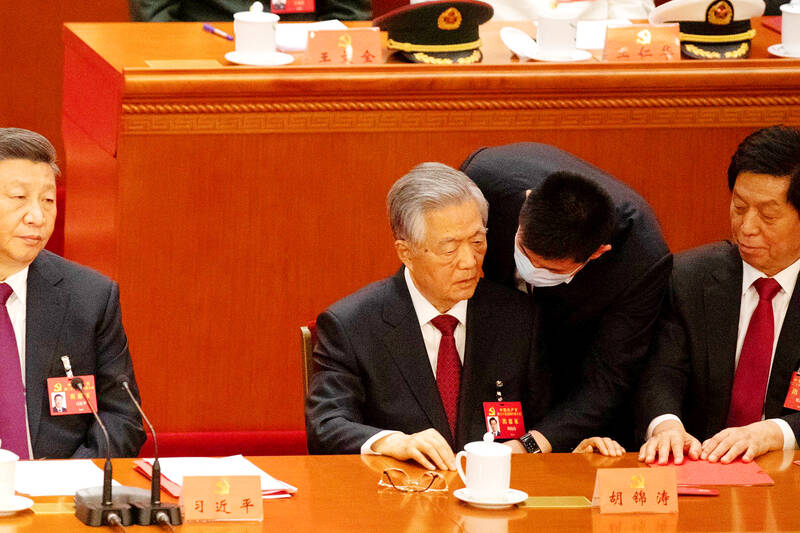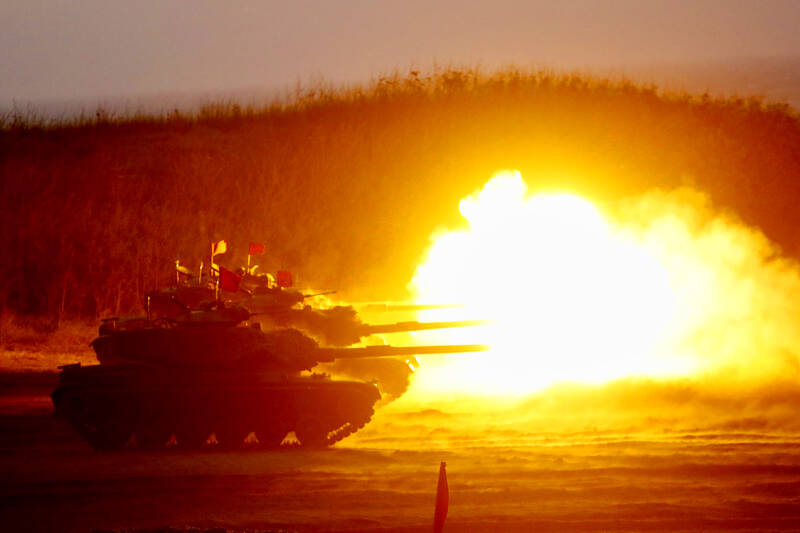The Chinese-language United Daily News reported last week that China had set a target of 676 cross-strait flights weekly for the coming year. The first iteration of tourism from China during the administration of Ma Ying-jeou (馬英九) was all about building a fantasy Taiwan for Chinese tourists to experience, while constructing links to local networks that could act on China’s behalf, redirecting Taiwan’s domestic investment to tourism activities and reducing its electronics exports (purchases of New Taiwan dollars by millions of tourists annually drive up its value).
The tourists were withdrawn with the election of President Tsai Ing-wen (蔡英文), which rendered that strategy fruitless and further application pointless, not as “punishment” to Taiwan for electing Tsai, as so many in the media reported. They were part of a “peace offensive” aimed at presenting China as interested in peaceful engagement with Taiwan.
More of that is inbound.

Photo: Bloomberg
Chinese leader Xi Jinping’s (習近平) “unprecedented” — except for Mao Zedong (毛澤東) and Deng Xiaoping (鄧小平); it was Hu Jintao (胡錦濤) and Jiang Zemin (江澤民) who were exceptions — continuance of dictatorial powers has been widely viewed as bad for Taiwan. Commentators have noted that those appointed to the Central Politburo Standing Committee are largely loyalists unlikely to second-guess Xi’s decisions. His military chieftainships are filled with Taiwan-oriented officers. A war cabinet, it is said.
KNOWING AGENTS, USEFUL IDIOTS
Ground must be laid for war, and that includes a “peace offensive” carried out by both knowing agents and useful idiots, aimed at both foreign and domestic audiences, the former to slow the response to China’s military build-up, the latter to legitimate the war in local eyes.

Photo: EPA-EFE
Several of us who track the media have noticed what appears to be a coordinated push across many publications for “peace.” The latest example of this is a publication from the Quincy Institute, the Koch-funded think tank that typically adopts pro-China and pro-Russia positions, which it repurposes as “peace” moves.
Quincy’s latest, “Ending the Destructive Sino-US Interaction Over Taiwan: A Call for Mutual Reassurance,” was written by Michael D Swaine, a senior fellow at the Carnegie Endowment for International Peace, which has institutional branches in China.
Swaine’s calls for changes in the Taiwan-US-China relationship echo the prescription offered in the recent Foreign Affairs piece by Thomas Christianson, Jessica Chen Weiss (白潔曦) and others, which I commented on last week. Similar works have been appearing elsewhere.
These pieces follow a specific pattern. First, America is accused of backing away from its “One China” policy, but the specifics of that policy are never named. With comments like “A few current and former US officials and military officers have hinted that Taiwan policy should be predicated on preventing China from unifying with Taiwan, but the current US administration has not made this an official position, which would destroy the One China policy,” Swaine appears to imply that the US as a matter of policy makes Taiwan part of China, when the opposite is true.
As I noted last week, when the US policy that Taiwan is not part of China is correctly identified, arguments like Swaine’s become instantly understandable as pro-Beijing propaganda. Swaine has been told many times what the US position is.
Both Swaine’s essay and the Foreign Affairs essay I wrote about last week contend that the US has moved away from its old position on Taiwan. The reason that happened is obvious: despite 40 years of assurances, Beijing built up its military. The US is responding to this change. This causation generally falls out of pieces in this genre.
REMOVING TAIWAN’S AGENCY
A second pattern is the removal of Taiwan’s agency. Swaine does this by repositioning Taiwan as a fantasy object of Beijing’s fears and desires, thus removing its own independent existence. The word “people” does not even occur in the text, while “independence” generally occurs in the context of “Beijing’s fears,” part of the tiresome “Beijing sees…” formulation so dear to the hearts of Beijing’s defenders.
Writing as if the stated motivations of actors are their real motives is a classic propaganda move. It is also an orientalist move that positions Beijing as motivated by sincere “feelings” while Washington is driven by malign “interests.”
This same pattern of Orientalization occurs in another Quincy specialty, calling for “peace” in Ukraine, positioning Russia as invading Ukraine out of fear of encirclement by NATO while describing the US as being driven by malign interests. And, of course, ignoring Ukrainian agency.
Swaine calls for the US to reduce mil-mil contacts, halt its intelligence activities and “maritime” activities off China’s coast, “or at least in the vicinity of Taiwan.” Rarely for the pro-China side, Swaine says that China should reduce “offensive ballistic missiles, amphibious platforms and minelayers” while the US reduces weapons sales to Taiwan. He concedes that this is impossible, at present. He is not wrong.
The essay, like the Foreign Affairs piece, assumes that at some point Taiwan will become part of China and that the pro-democracy side in Taiwan should simply shut up about it.
“For Taipei, this would mean finding some language that does not preclude the possibility of an eventual One China outcome,” he says.
Swaine thus appears to be perfectly comfortable packing Taiwanese off to camps, and with the follow-on wars that will occur once China has Taiwan. If history teaches anything, it is that the outcome of imperialism is always more imperialism. It stops only when the imperialist is physically checked.
In addition to its flow of pro-China and pro-Putin pieces, Quincy had a hand in the recent, dangerously stupid letter calling for “peace” in Ukraine from a group of progressives in the US congress. Vox (“The drama over progressives’ Ukraine letter,” Jonathon Guyer, Oct. 26), explained: “An early draft of the congressional letter was reviewed by the Quincy Institute, which helped build support for it and has advocated for more avenues of diplomacy outside this letter.”
Josh Marshell of Talking Points Memo fame argued in a long Twitter thread that the letter itself appeared to be a Quincy project.
“I’ll note that the Quincy folks were pretty pumped when the letter came out and seemed to have their own write up pretty much right when the Post broke the story,” he pointed out.
The effort by “serious” writers to pimp China talking points is taking place as China conducts a major influence effort ahead of the US mid-terms. NBC reported (“Pro-China social media campaign sought to influence US voters, researchers say,” Kevin Collier, Oct. 26) that two firms that analyze social media had identified the campaign.
These are all one. The pro-China campaign we will face in the coming years is a hydra-headed thing, running the gamut from nice upper-class commentators from fancy organizations like Quincy to academics forwarding Beijing’s fantasy history to QAnon promoters from the darkest corners of the Web.
As China moves toward war, the cacophony will increase, and the alternate epistemic world it constructs will only grow richer and more influential.
Shout louder, folks.
Notes from Central Taiwan is a column written by long-term resident Michael Turton, who provides incisive commentary informed by three decades of living in and writing about his adoptive country. The views expressed here are his own.

On April 26, The Lancet published a letter from two doctors at Taichung-based China Medical University Hospital (CMUH) warning that “Taiwan’s Health Care System is on the Brink of Collapse.” The authors said that “Years of policy inaction and mismanagement of resources have led to the National Health Insurance system operating under unsustainable conditions.” The pushback was immediate. Errors in the paper were quickly identified and publicized, to discredit the authors (the hospital apologized). CNA reported that CMUH said the letter described Taiwan in 2021 as having 62 nurses per 10,000 people, when the correct number was 78 nurses per 10,000

As we live longer, our risk of cognitive impairment is increasing. How can we delay the onset of symptoms? Do we have to give up every indulgence or can small changes make a difference? We asked neurologists for tips on how to keep our brains healthy for life. TAKE CARE OF YOUR HEALTH “All of the sensible things that apply to bodily health apply to brain health,” says Suzanne O’Sullivan, a consultant in neurology at the National Hospital for Neurology and Neurosurgery in London, and the author of The Age of Diagnosis. “When you’re 20, you can get away with absolute

May 5 to May 11 What started out as friction between Taiwanese students at Taichung First High School and a Japanese head cook escalated dramatically over the first two weeks of May 1927. It began on April 30 when the cook’s wife knew that lotus starch used in that night’s dinner had rat feces in it, but failed to inform staff until the meal was already prepared. The students believed that her silence was intentional, and filed a complaint. The school’s Japanese administrators sided with the cook’s family, dismissing the students as troublemakers and clamping down on their freedoms — with

As Donald Trump’s executive order in March led to the shuttering of Voice of America (VOA) — the global broadcaster whose roots date back to the fight against Nazi propaganda — he quickly attracted support from figures not used to aligning themselves with any US administration. Trump had ordered the US Agency for Global Media, the federal agency that funds VOA and other groups promoting independent journalism overseas, to be “eliminated to the maximum extent consistent with applicable law.” The decision suddenly halted programming in 49 languages to more than 425 million people. In Moscow, Margarita Simonyan, the hardline editor-in-chief of the